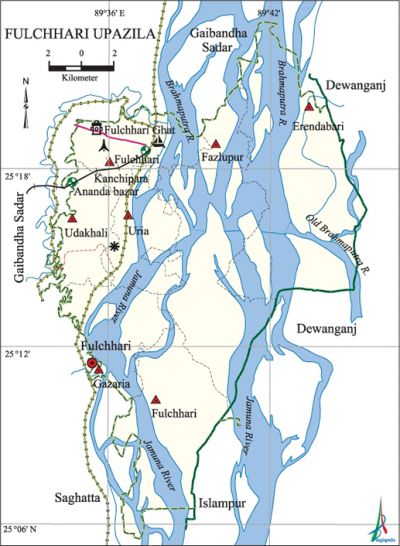Fulchhari Upazila
Fulchhari Upazila (gaibandha district) area 314.03 sq km, located in between 25°06' and 25°23' north latitudes and in between 89°34' and 89°46' east longitudes. It is bounded by gaibandha sadar upazila on the north, saghatta and islampur upazila on the south, dewanganj upazila on the east, Gaibandha Sadar and Saghatta upazilas on the west. Vast area of the upazila is char land.
Population Total 165334; male 82523, female 82811; Muslim 159060, Hindu 5773, Buddhist 1, Christian 1 and others 499.
Water bodies Main rivers: brahmaputra, old brahmaputra, jamuna.
Administration Fulchhari Thana was formed on 25 February 1855 and it was turned into an upazila in 1984.
| Upazila | ||||||||
| Municipality | Union | Mouza | Village | Population | Density (per sq km) | Literacy rate (%) | ||
| Urban | Rural | Urban | Rural | |||||
| - | 7 | 78 | 85 | 6401 | 158933 | 526 | 42.8 | 30.8 |
| Upazila Town | ||||||||
|
Area (sq km) |
Mouza |
Population |
Density (per sq km) |
Literacy rate (%) | ||||
| 11.08 | 1 | 6401 | 578 | 42.8 | ||||
| Union | ||||
| Name of union and GO code | Area (acre) | Population | Literacy rate (%) | |
| Male | Female | |||
| Uria 83 | 5836 | 8458 | 8599 | 33.5 |
| Udakhali 71 | 5171 | 12328 | 12976 | 41.7 |
| Erendabari 11 | 21525 | 14530 | 14546 | 27.0 |
| Kanchipara 59 | 6608 | 13242 | 13825 | 42.1 |
| Gazaria 47 | 7118 | 9750 | 9572 | 32.4 |
| Fazlupur 23 | 18104 | 11427 | 11151 | 22.9 |
| Fulchhari 35 | 13238 | 12788 | 12142 | 17.7 |
Source Bangladesh Population Census 2011,Bangladesh Bureau of Statistics.

Historical events In 1956 a three-day peasant conference convened by Maulana abdul hamid khan bhasani was held at Sardarer Char. The historic tebhaga movement spread over the upazila in 1946.
War of Liberation The Pak army conducted indiscriminate genocide, rape, plundering and violation of women in the upazila. They also set many houses on fire. An encounter between the freedom fighters and the Pak army and rajakars was held at Uria in which a number of Pak soldiers and rajakars were killed. The freedom fighters however, captured huge amount of arms and ammunitions of the Pak army. In an encounter with the Pak army at Fazlupur one freedom fighter was killed. On 3 December the freedom fighters attacked the Fulchhari Police Station and captured huge amount of arms and ammunitions. On 4 December an encounter was held between the freedom fighters and the Pak army at Fulchhari in which 27 Pak soldiers were killed and so were 5 freedom fighters. Fulchhari upazila was liberated on 9 December. There is a mass grave and two mass killing sites in the upazila.
For details: See ফুলছড়ি উপজেলা, বাংলাদেশ মুক্তিযুদ্ধ জ্ঞানকোষ (Encyclopedia of Bangladesh War of Liberation), বাংলাদেশ এশিয়াটিক সোসাইটি, ঢাকা ২০২০, খণ্ড ৬।
Religious institutions Mosque 245, temple 6.
Literacy rate and educational institutions Average literacy 31.2%; male 34.6%, female 27.9%. Educational institutions: college 1, secondary school 8, primary school 69, madrasa 15. Noted educational institutions: Fulchhari Pilot High School (1940), Kanchipara Academy (1960).
Cultural organisations Club 9, women society 5, playground 8.'
Main sources of income Agriculture 75.15%, non-agricultural labourer 3.35%, industry 0.52%, commerce 8.11%, transport and communication 2.49%, service 3.46%, construction 1.23%, religious service 0.22%, rent and remittance 0.44% and others 5.03%.
Ownership of agricultural land Landowner 60.03%, landless 39.97%; agricultural landowner: urban 24.53% and rural 61.71%.'
Main crops Paddy, wheat, sugarcane, maize, jute, black gram, onion, chili, mustard, peanut, vegetables.
Extinct or nearly extinct crops Barley, kaun, sweet potato.
Main fruits Mango, jackfruit, banana, papaya.
Fisheries, dairies and poultries Fishery 212, dairy 28, poultry 44, hatchery 15.
Communication facilities Pucca road 33.43 km, Semi-pucca road 2.93 km, mud road 220.65 km.
Extinct or nearly extinct traditional transport Palanquin, horse carriage, bullock cart.
Noted manufactories Rice mill, saw mill, printing press.
Cottage industries Goldsmith, blacksmith, potteries, bidi factory, wood work, cane work.
Hats, bazars and fairs Hats and bazars are 12, fairs 2, most noted of which are Kanchipara Hat, Udakhali Hat, Fulchhari Hat and Aushtami Mela at Fulchhari Bazar.
Main exports Mustard, peanut, black gram, onion, chili, vegetables.
Access to electricity All the unions of the upazila are under rural electrification net-work. However 23.6% of the dwelling households have access to electricity.
Sources of drinking water Tube-well 94.3%, tap 0.1% and others 5.6%.
Sanitation 39.7% of dwelling households of the upazila use sanitary latrines and 41.6% of dwelling households use non-sanitary latrines; 18.7% of households do not have latrine facilities.
Health centres Upazila health complex 1, union health centre 1, health and family welfare centre 3, satellite clinic 42.
NGO activities Operationally important NGOs are brac, CARE, proshika. [Zahurul Qayum]
References Bangladesh Population Census 2001 and 2011, Bangladesh Bureau of Statistics; Cultural survey report of Fulchhari Upazila 2007.
